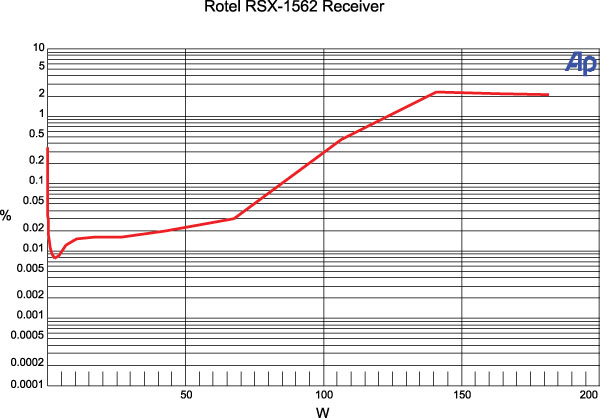Rotel RSX-1562 A/V Receiver HT Labs Measures
Two channels driven continuously into 8-ohm loads:
0.1% distortion at 85.6 watts
1% distortion at 124.3 watts
Five channels driven continuously into 8-ohm loads:
0.1% distortion at 85.5 watts
1% distortion at 124.0 watts
Seven channels driven continuously into 8-ohm loads:
0.1% distortion at 84.8 watts
1% distortion at 123.4 watts
Analog frequency response in Bypass mode:
–1.95 dB at 10 Hz
–0.57 dB at 20 Hz
–0.58 dB at 20 kHz
–4.44 dB at 50 kHz
Analog frequency response with signal processing:
–2.24 dB at 10 Hz
–0.67 dB at 20 Hz
–0.59 dB at 20 kHz
–44.82 dB at 50 kHz

This graph shows that the RSX-1562’s left channel, from CD input to speaker output with two channels driving 8-ohm loads, reaches 0.1 percent distortion at 85.6 watts and 1 percent distortion at 124.3 watts. Into 4 ohms, the amplifier reaches 0.1 percent distortion at 163.8 watts and 1 percent distortion at 237.1 watts.
Response from the multichannel input to the speaker output measures –1.94 dB at 10 Hz, –0.57 dB at 20 Hz, –0.58 dB at 20 kHz, and –4.45 dB at 50 kHz. THD+N from the CD input to the speaker output was less than 0.016 percent at 1 kHz when driving 2.83 volts into an 8-ohm load. Crosstalk at 1 kHz driving 2.83 volts into an 8-ohm load was –85.04 dB left to right and –78.82 dB right to left. The signal-to-noise ratio with an 8-ohm load from 10 Hz to 24 kHz with “A” weighting was –95.81 dBrA.
From the Dolby Digital input to the loudspeaker output, the left channel measures –0.45 dB at 20 Hz and –0.64 dB at 20 kHz. The center channel measures –0.41 dB at 20 Hz and –0.72 dB at 20 kHz, and the left surround channel measures –0.42 dB at 20 Hz and –0.62 dB at 20 kHz. From the Dolby Digital input to the line-level output, the LFE channel is –0.03 dB at 20 Hz when referenced to the level at 40 Hz and reaches the upper 3-dB down point at 108 Hz and the upper 6-dB down point at 115 Hz. —MJP
Video Test Bench
From an HDMI input to an HDMI output (the conditions under which our Video Test Bench tests on A/V receivers and surround preamp-processors are conducted), the Rotel performs no video deinterlacing or upconversion; its output resolution will always be the same as the input resolution. In the remaining tests that are valid here, all of which were performed with a 1080p input, the receiver’s passthrough performance was visibly flawless. —TJN






























































